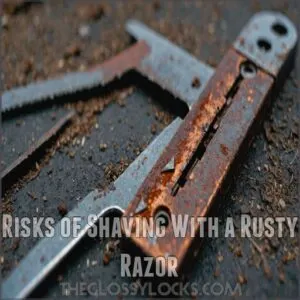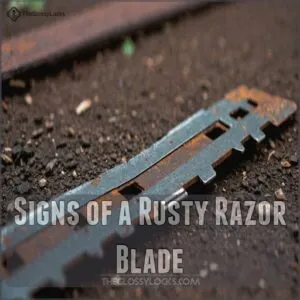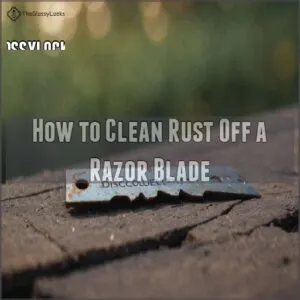This site is supported by our readers. We may earn a commission, at no cost to you, if you purchase through links.
 Shaving with a rusty razor is like playing with fire—you’re asking for trouble!
Shaving with a rusty razor is like playing with fire—you’re asking for trouble!
That dull blade can irritate your skin, cause ingrown hairs, and even lead to painful infections like staph and cellulitis.
Rust isn’t just a scary color; it’s a troublemaker that can bring impetigo and boils right into your routine.
If your razor feels like it’s pulling more than cutting, or gives off a metallic stink, toss it.
Save yourself the headache by keeping your shave smooth and clean.
Want to know how to avoid these pitfalls and maintain your blades like a pro?
Keep reading for the scoop!
Table Of Contents
- Key Takeaways
- Risks of Shaving With a Rusty Razor
- Signs of a Rusty Razor Blade
- Causes of Rust on Razor Blades
- Can You Remove Rust From a Razor Blade?
- How to Clean Rust Off a Razor Blade
- Frequently Asked Questions (FAQs)
- Can You shave with a rusty razor blade?
- Do you use Rusty razors?
- Can You shave with an old razor?
- Does a rusty razor affect the shaving experience?
- Is it bad to shave with a rusted razor?
- What happens if I shave with a dirty razor?
- What to do if I cut myself with a rusty razor?
- What to do if your razor is rusty?
- How often should razor blades be changed?
- What materials prevent rust on razors?
- Can shaving cream cause razor rust?
- How does hard water affect razor blades?
- Are stainless steel blades more rust-resistant?
- Conclusion
Key Takeaways
- Don’t shave with a rusty razor—it’s a breeding ground for bacteria, leading to infections like staph and cellulitis.
- A dull, rusty blade causes skin irritation, razor burn, and ingrown hairs due to its pulling instead of cutting.
- Prevent rust by storing your razor in a dry place, rinsing it after use, and avoiding contact with hard water minerals.
- Regularly cleaning and maintaining razor blades with techniques such as rinsing under warm water can also help prevent rust and extend their lifespan. Regularly check and replace razor blades every 5 to 10 shaves to maintain a smooth and safe shaving experience.
Risks of Shaving With a Rusty Razor
Using a rusty razor is a bad idea; you’re risking serious skin infections from bacteria lurking on that rusty blade.
Think of all the tiny nicks—they’re open doors for infection, so please, ditch the rusty razor!
Skin Irritation and Infections
Ever wondered why a rusty razor spells trouble for your skin? It’s a recipe for disaster, leading to nasty irritations and infections.
Imagine these:
- Painful skin irritation
- Risk of staph infection
- Scary cellulitis flair-ups
So, ditch that rusty razor! Protect your skin and steer clear of unexpected, uncomfortable surprises. Your skin deserves the care, not a horror show.
Ingrown Hairs and Razor Burn
When battling skin irritation, rusty razors can sneak in nasty razor burn and ingrown hairs.
That dull, rusty blade? It tugs, not cuts, leading to bumps and redness you’d rather not face.
Put a stop to the burn with fresh blades, smart shaving techniques, and post-shave care.
Exfoliate before shaving to help keep ingrown hairs at bay.
Nicks and Cuts
Those pesky ingrown hairs often come with friends—nicks and cuts.
Shaving with a rusty razor? You’re skating on thin ice.
This dull razor blade barely cuts, it scrapes, leaving you vulnerable.
Consider upgrading to a sharper shaving razor for sale online, shaving razor products.
Keep a first aid kit handy and practice good shaving techniques.
Dab a bit of rubbing alcohol to sterilize and dodge infection.
Razor safety first, folks!
Bacterial Infections Like Staph and Cellulitis
Using a rusty razor isn’t just a grooming faux pas; it’s a risky move inviting bacterial infections like staph and cellulitis.
Noticed some redness or swelling? That’s a red flag!
Regular razor blade hygiene, which can be achieved through methods such as natural sanitizing solutions, and rust prevention with cotton balls soaked in mineral oil can keep infections at bay.
Don’t share razors, and always prioritize infection treatment over shortcuts.
Impetigo and Boils
Razor hygiene isn’t just for looks; it’s vital in warding off infections like impetigo and boils.
Imagine staph infection finding a way through a tiny cut. It can lead to itchy, crusty blisters.
Keep your skin care routine sharp and safe. Swap out that rusty razor. Consider investing in a straight razor or adding camellia oil to your regimen.
Signs of a Rusty Razor Blade
Have you noticed your shave feeling less like a glide and more like a tug-of-war?
That hair tugging might mean you’re facing a rusty razor blade.
Check for discoloration—it can signal not just rust spots but also bacteria and lime scale.
Regular use of a shaving cream from a reliable source like shaving cream products can sometimes help keep your skin clear of irritation.
If the blade’s texture begins to feel rough or gritty, that’s a red flag.
Another hint a rusty razor might be lurking in your bathroom is an odd, metallic odor.
Remember, keeping your razor in a dry spot with a razor holder or a razor travel case when not in use can help avoid these issues.
If you think your razor may be rusting, it’s better safe than sorry—replace it before risking an infection.
Causes of Rust on Razor Blades
So, what causes that nasty rust on your razor blades? It’s usually a combo of leftover moisture causing oxidation, plus maybe some less-than-ideal storage habits.
Moisture and Oxidation
Ever notice how your trusty razor turns into Mr. Rusty after a few showers?
Moisture and oxidation are the culprits here.
To keep those blades pristine, consider these tips and learn how to remove rust from razor blades using simple methods like castile soap and vinegar.
- Rust prevention: Store blades in a dry spot.
- Water hardness matters: Use filtered water.
- Air humidity: Reduce bathroom humidity with ventilation.
Disinfecting your razor blades regularly with methods such as proper razor blade disinfection helps to prevent bacteria transfer and skin infections. Keep shaving safe and smooth!
Improper Storage and Maintenance
Picture your razor sitting in a humid bathroom—a fast track to rust city.
Having the right tool, like a safety razor from a reliable source safety razor products, can also help prevent rust and other issues.
Keep it dry, and you’re golden.
Store it upright to allow water to drip away.
Always dry the blade thoroughly after each use.
With proper razor hygiene, you’ll sidestep rust and maintain a sleek, smooth shave, saving money and nicks in the long run.
Using Tap Water With High Mineral Content
Think of your razor blade as a soldier, valiantly battling facial hair.
However, hard water with its stealthy mineral deposits weakens this warrior, leading to rust.
Use a water softener to minimize mineral buildup and embrace rust prevention.
Your blade will glide effortlessly, cutting smoothly without surrendering to the relentless effects of hard water.
Stay sharp, my friend!
Touching The Blade With Bare Hands
After rinsing with tap water, touching your razor’s blade with bare hands can speed up rust formation.
Your fingers leave behind oils and moisture, turning your blade into a rust magnet.
This dulls the blade but also ups the hygiene risks, leading to skin irritation.
Keep it clean, handle with care, and prevent unnecessary infection headaches.
Can You Remove Rust From a Razor Blade?
You might think removing rust from a razor blade is a quick fix, but safety should always be your top priority.
If your razor is rusted, consider ditching it for a new one—it’s not worth the risk of cuts or infections.
Safety Razors and Straight Razors
Staring at a rusty safety razor or straight razor can be unnerving, but you can rescue it. Here’s how:
- Sharpening: Use a leather strop to keep blades keen.
- Maintenance: Store blades in a dry place to prevent rust.
- Cost Comparison: Invest in a quality blade to avoid frequent replacements.
Keep your razor sharp, ensuring smooth, nick-free shaves.
Cartridge Razors and Disposable Razors
Unlike safety razors, you can’t restore rusty cartridge or disposable razors.
Their design prevents cleaning.
Consider their shorter cartridge lifespan: it’s better to toss them.
Proper blade disposal is key.
Explore eco-friendly options for a cleaner shave and planet.
The disposable vs. safety razor debate boils down to convenience versus cost and environmental impact.
Multi-blade benefits are offset by waste.
Precautions and Safety Measures
Rust on a razor blade? That’s a risky slice of life!
Regular cleaning with castile soap and proper drying can prevent rust, learn how to de rust razor blades quickly.
Keep your blades rust-free with good razor blade hygiene.
Always dry and store them properly to prevent rust.
Sharing razors might seem friendly, but it’s a shortcut to infection and tetanus risk.
Remember, a rusty razor equals trouble—better safe than sorry, so always check your blades!
How to Clean Rust Off a Razor Blade
You don’t have to toss your razor just because it’s rusty; a little cleaning magic can make it usable again.
Grab some vinegar, sea salt, and rubbing alcohol, and with a few simple steps, you’ll be shaving safely in no time.
Gathering Materials (Vinegar, Sea Salt, and Rubbing Alcohol)
So, you’ve decided to tackle that rust yourself.
Grab vinegar, sea salt, and rubbing alcohol—they’re your trusty sidekicks for DIY rust removal.
These ingredients aren’t just easy to find; they’re safe for the environment too.
Ready them with care, considering safety precautions to keep the bacteria at bay.
Remember, ingredient availability is key for this alternative cleaning method!
Rinsing The Razor Blade
After each shave, rinse the razor blade under warm water to dislodge any gunk.
Use gentle motions to avoid blade damage, as you’re aiming for precision, not a wrestling match.
Rinse frequently, especially if you’re tackling the tricky task of cleaning rust.
Pat the blade dry with a soft towel to prevent moisture from cozying up and inviting rust.
Soaking The Razor in Vinegar
For cleaning a rusty razor, a splash of vinegar can work wonders!
Soak the blade in white vinegar for at least 30 seconds to tackle the rust.
Vinegar’s effectiveness is legendary, but if you’re not keen on its aroma, lemon juice might be a fun alternative.
Make sure the blade’s completely submerged, ensuring its safety and freshness.
Creating a Cleaning Paste
Grab some sea salt and vinegar to whip up a rust-busting cleaning paste.
Mix until it’s got a gritty toothpaste consistency.
Now you’ve got a powerful tool to fight rust.
Apply this magical concoction to your razor, making sure it’s well-coated.
Who knew pasta-making (or paste-making) could save your shaving routine this easily?
Scrubbing and Rinsing The Razor Blade
Now, gently scrub the blade with your toothbrush, ensuring you reach every nook and cranny.
Rinse the blade thoroughly under hot, running water.
Pat it dry with a soft towel; this helps prevent future rust.
Remember, regular razor blade care, including frequent cleaning and replacement, is key to a smooth, safe shave.
Don’t forget to use hot water for best results!
Frequently Asked Questions (FAQs)
Can You shave with a rusty razor blade?
Shaving with a rusty razor is a bad idea.
It can cause painful skin infections and possibly lead to painful bumps or worse.
Cleaning razor blades with a disinfecting agent like alcohol for razor blades helps prevent the spread of bacteria and infections, keeping blades clean and replacing them often keeps your skin safe and shave smooth.
Do you use Rusty razors?
Using a rusty razor isn’t worth the risk—bacteria like staph can cause serious skin infections.
It’s like letting a moldy sandwich near your face.
Cleaning your razor regularly by using baking soda helps remove residue and prevent rust, a key step in keeping your shave clean and sharp for safety and comfort.
Can You shave with an old razor?
You can shave with an old razor, but it’s not ideal.
A dull blade tugs at your skin, causing nicks, irritation, and razor burn.
For a smooth, pain-free shave, replace blades before they lose their edge.
Does a rusty razor affect the shaving experience?
Imagine a rusty blade as a wolf in sheep’s clothing.
It might seem like just another razor, but it harbors bacteria, causing infections, irritation, and painful shaves.
Keep your grooming routine smooth and safe!
Is it bad to shave with a rusted razor?
Seriously, don’t shave with a rusty razor!
It’s a breeding ground for bacteria, leading to nasty infections.
Toss that rusty thing and grab a new, sharp blade.
Your skin will thank you.
What happens if I shave with a dirty razor?
Using a dirty razor spells trouble for your skin.
It can lead to infections, irritation, and razor burn.
Don’t let germs and bacteria have a field day—clean your razor regularly for a safe, smooth shave.
What to do if I cut myself with a rusty razor?
Wash the cut with soap and water, then apply an antibiotic ointment.
Keep an eye on it for signs of infection like redness or pus.
If it worsens, see a doctor.
Better safe than sorry!
What to do if your razor is rusty?
Ah, the joys of discovering a rusty razor!
Toss it immediately and save yourself from potential infections.
Remember to store razors in a dry place and rinse them after each use to prevent rust and bacteria buildup.
How often should razor blades be changed?
To minimize the risk of infection, maintaining a clean and dry razor is crucial, and learning how to prevent razor blade corrosion can make a big difference. Swap your razor blade every 5 to 10 shaves.
If you’re shaving larger areas daily, change it more often.
A sharper blade means fewer cuts and irritation.
Trust me, your skin will thank you!
What materials prevent rust on razors?
Don’t let a little rust rob you of a clean shave!
Stainless steel or coated blades resist rust well.
Always store razors in a dry spot, and give them a quick towel pat after each use.
Can shaving cream cause razor rust?
Shaving cream itself doesn’t cause rust, but if it mixes with water and isn’t cleaned off properly, it can lead to moisture build-up.
This trapped moisture, not the cream alone, can make razors rust.
How does hard water affect razor blades?
Hard water’s minerals dull your razor blades faster.
They leave deposits, making it harder to get a clean shave.
Regular blade changes are key to avoiding irritation and infections.
You’ll thank yourself later!
Are stainless steel blades more rust-resistant?
Picture your car cruising through a rainstorm without rusting; stainless steel blades are like that.
They’re more rust-resistant due to added chromium, making them durable and a smart choice for your shaving routine.
Keep it sleek!
Conclusion
Picture a battle-hardened sword—rusted and weakened.
A rusty razor does the same to your shave, bringing skin troubles and infections.
Don’t let a rusty blade be the hero of your morning routine when smooth, irritation-free skin awaits.
By keeping your razors clean and sharp, you’re investing in comfort and health.
Remember, a quick check and a little maintenance go a long way.
Avoiding that rusty razor isn’t just smart—it’s essential for happy, healthy skin.










